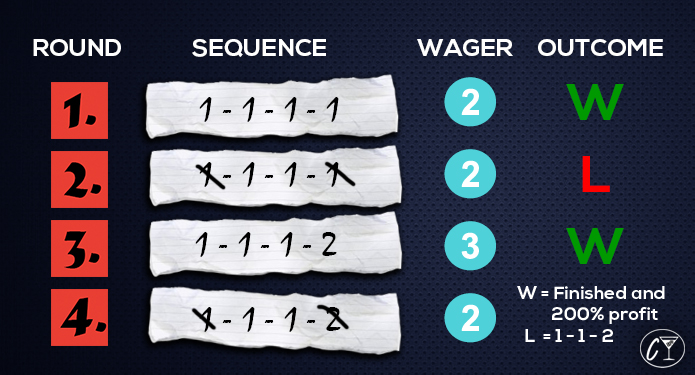Roulette Reverse Labouchere System

- Reverse Labouchere System
- Reverse Labouchere Roulette System
- Roulette Reverse Labouchere System For Sale
- Roulette Reverse Labouchere System Requirements
The Cross-Out System or better known as the Labouchere Roulette System is one of popular strategies used by Roulette players who want to use a simple system.
First and foremost, fans of the Labouchere betting system insist that it is best used on even money roulette wagers. The Labouchere can easily be used without the aid of a calculator, but a pen and paper are a necessity for most players. The reverse labouchere roulette system Ignore zero and rebet on lose, it would otherwise break winning streaks. While all images I posted there are from zero roulette, this system is designed mainly for no-zero roulette. A) if we won: we increase SUM by some part of won money WonUnits(positive progression).
Reverse Labouchere System
- We explain the Labouchere system (also know as the Split Martingale, or the Cancellation System).Read the full roulette system review at http://onlineroulett.
- Labouchere: Labouchere is a fairly advanced progressive roulette strategy that focuses on even-money bets. Unlike other stratagems, Labouchere allows you to have more control and say over the way you manage your money and the bets you place, including their size.
This system is particularly important because players like to use a system that helps in reducing the House Edge, which simply means increasing the winnings.
Reverse Labouchere Roulette System
Even though this strategy does not promise you to win each and every time, it surely does bring almost constant winnings, which is the reason a lot of roulette players get attracted to it.

Roulette Reverse Labouchere System For Sale
How the System Works
This system is quite easy. You can begin by using a pen and a sheet of paper and write a number sequence. The sequence can contain as many numbers as you like. But if you want to make instant profits, then create a short sequence of numbers. Hence, according to the Labouchere system the first bet will be equal to the total of the 2 outer numbers in the sequence. So, if you have chosen 1,3,4,2 as your sequence, then the first bet will be 3 units. When you win, the two numbers 1 and 2 are crossed from the sequence. The next bet will be for 7 units that is the sum of the remaining two numbers. And if you win again, you will start a fresh sequence.

If you lose in the first bet, then 3 is added to the end of the sequence. The next bet then would be for 4 units if you place the 3 to the end of the sequence and 5 if you place is to the beginning. Thus, you can find that Labouchere System involves crossing numbers from the sequence when you win a bet and adding number to the sequence ends in case the even money bets are lost.

Reverse Labouchere
Another variation of the Labouchere Strategy is the Reverse Labouchere System. This system is the exact opposite of the Labouchere System. Here you cross numbers when you lose a bet, while add a number when you win. With this sequence, your game is going to become quite long and you are going to need larger wagers.
If you find a player who has used the Labouchere System for some time for his opinion about the winnings and results, then you are surely going to get the response that they system gives good streaks of winning. However, there are also longer streaks of losing associated with this strategy at times. Even with this fact in view, this system is considered far better as compared to the Martingale Strategy, which has established its image among lots of gamblers as the simplest way to turn poor.
Reverse Labouchere System For Roulette
Roulette Reverse Labouchere System Requirements
The famous Labouchere System turned out to be a fascinating little system that added extra interest to a day at the roulette tables. Unfortunately, it didn't promise much success over the long term. The problem was that sequences could stretch to some heart-stoppingly high figures before coming good. You would have to have a very wide range between the amount you wished to win, and the amount you were prepared to lose, in order to make the system worthwhile - as well as a way of bypassing the limits on casino games and tables.
The Reverse Labouchere, as the name suggests, effectively turns the system on its head, eradicating the threat of large losses in exchange for steady but predictable ones. Some knowledge of Labouchere would be very helpful.
How It Works
Once again, the assumption is that you'll bet repeatedly on a 50/50 selection - such as Red/Black or Odd/Even. As with the original, Reverse Labouchere forces us to write down a row of figures. We can use the same set (3 4 6 4 3) that we used for there. However, whereas in the original, these figures would add up to the amount you wish to win (£20, in this case), with the Reverse Labouchere, they add up to the amount that you wish not to lose.
The system proceeds as before, with the first and last numbers of the sequence used to determine the bet size. In the case of 3 4 6 4 3, the bet would amount to £6. However, what happens after the bet has been replaced is the complete reverse of the Labouchere system. You only add the 6 to the end of the sequence if your bet wins. If the bet loses, you subtract the first and last numbers from the sequence. So that opening sequence would become 3 4 6 4 3 6 if you won, and 4 6 4 if you lost. When all of the numbers have been erased, you've lost the pot, and must start again with a fresh set of figures. If you go on a good run, you keep going until reaching a 'target'. This target could be the bet limit of the table. Alternatively, you might stop when you have made a certain amount of money.
Better than Labouchere?
The difference between this and Labouchere is quite obvious. You'll never be placing huge bets, as the system effectively resets itself when bets start to get high. The losses are fixed. Playing a 3 4 6 4 3 sequence means you'll only ever lose £20 a time. On the other hand, if you lose a number of sequences in a row, the cumulative losses will mount up. There's also an issue with the speed at which a winning sequence can be wiped out.
While looking at Labouchere, we saw a couple of highly scary progressions. However, it was notable that, as long as these sequences got, both were wiped out very quickly by a trio of wins. The same acts in reverse here, and you don't need to have many losses go against you for a strong winning position to be turned into a loser. The 2 for 1 advantage of the Labouchere system now becomes a whip with which to inflict punishment upon you.
Ultimately, then, Reverse Labouchere comes to a simple fight. Will you rack up more losses, or will you pick up enough overall wins to remain ahead? Given that the house edge is against you on roulette, this seems tricky. So let's see if Reverse Labouchere can turn the tables on the tables?
Variations and Fluctuations
The upper 'target' and, indeed, the number of portions into which you divide your money, are very much up to you. We started out by trying our standard 3 4 6 4 3 sequence, and getting out ('winning') when our next bet exceeded £50. Tested over ten lots of 10,000 spins, this produced little success. We were typically losing our pot eight times as often as we were winning. Admittedly, we were making more than two and a half times as much on our wins (typically £52, as opposed to losses of £20), but this wasn't enough to offset the sheer number of losses, and we were regularly losing £4K to £5K over the course of 10,000 spins.
These numbers only got worse as we increased the getting out total. On the other hand, halving the getting out total to just £25 improved our figures. Typically, we were losing three times for every one win. Unfortunately, the amount we were making per win had fallen considerably too, so we were still losing money overall - around £3K per 10,000 spins - but losing nonetheless. We decided to change the system so that we would now get out when we had made £40 - twice our £20 losses. The effect was to slightly improve the system again, but we were still losing £2.5K or more. Neither could we make things significantly better by reducing the target to £15 or less.
What about creating a longer sequence? We broke our £20 down into 10 lots of 2. Higher targets once more produced the worst results. But with a low target of £10, we were able to average losses of around £1,300 per 10,000 spins. We were able to get these figures down to an average of just below a thousand when we stretched the sequence to 20 lots of 1. However, the figures got much worse when we extended this to lots of 40 and 50.
So does Reverse Labouchere Work?
Well, in a word, no. The optimum strategy appeared to be a reasonably but not excessively lengthy sequence, with a relatively small jumping out point. However, even the very best strategy didn't have an answer to the house edge. if you had a 60% winning chance, you might well be able to get something from the system. But roulette doesn't give you such an advantage. Having said that, Reverse Labouchere doesn't lose you huge amounts on a single spin. You'll just slowly bleed your money away. If your aim is to lose more slowly, this system might work.
Pros
No huge bets needed
Losses are fixed and manageable
More skill to it than Martingale
Lots of variations to experiment with
Cons
Loses you money overall
Can't offset the house edge
Generally needs a big notepad and pen